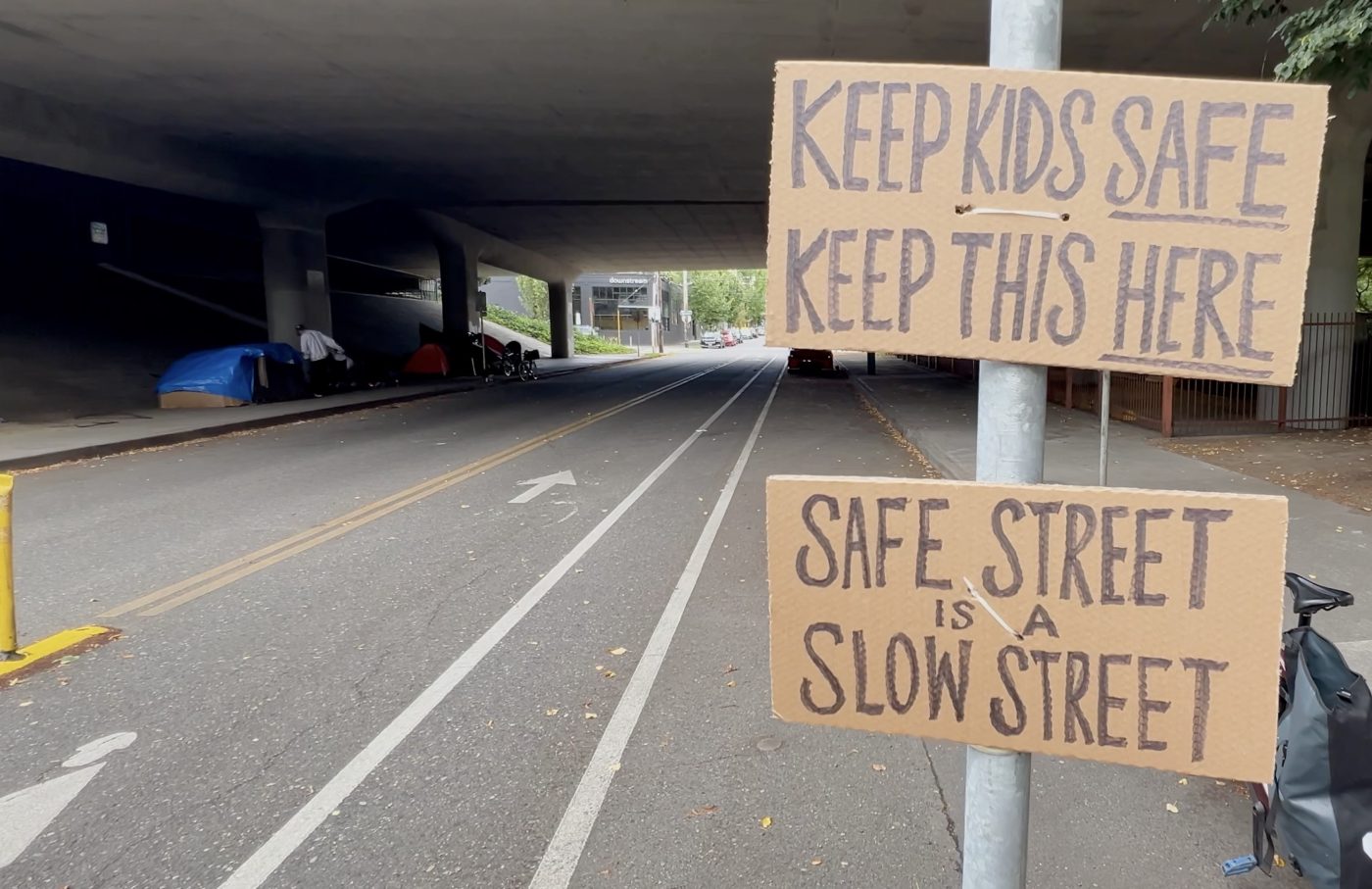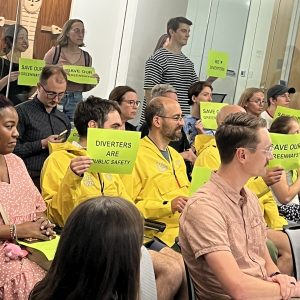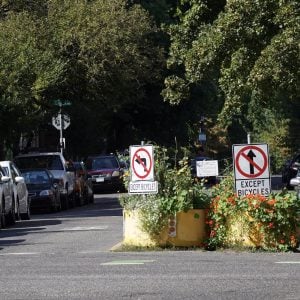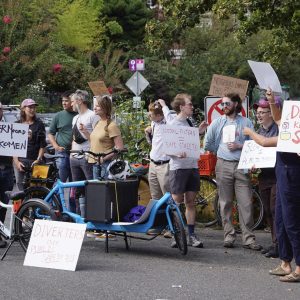Nearly two weeks after we first heard of a plan by the City of Portland to remove two traffic diverters on neighborhood greenways in northwest Portland, we have yet to hear directly from one of the main characters: the Portland Police Bureau. That now has changed as I’ve just read an email from the Central Precinct Commander that lays out their case.
Before I share that, I can also share the latest from Deputy City Administrator of Public Works Priya Dhanapal. In an email this morning to Mayor Keith Wilson’s office and other city leaders, Dhanapal confirmed the state of the pause on the city’s plans I reported yesterday. “After listening to your perspectives and reviewing recent feedback,” Dhanapal wrote. “I am writing to let you know that we are temporarily pausing to review the recommendation and allow for more consultation with community partners.”
Here’s more from Dhanapal’s email:
“When City Administrator Jordan is back next week, he will be providing an update outlining the issues that led to this recommendation and clarifying next steps, including our commitment to balancing public safety, transportation safety, and livability in our neighborhoods… Thank you for your leadership and advocacy on behalf of our city as we navigate a complex and emotional issue together, with both transparency and care for the communities we serve.”
Dhanapal also shared a message from PPB Central Precinct Commander Brian Hughes. Thus far PPB have been quiet about the issue, even though their patrols are central to the rationale for the diverter removal plan. An officer I asked for comment on August 1st has not responded to me. And in a story published this morning by Oregon Public Broadcasting, they say the PPB declined to comment.
Here’s the message Commander Hughes shared with city leaders:
Thank you for including me in this discussion. I want to provide some law enforcement context on the public safety considerations that informed our support for removing the NW 20th Ave traffic diverters.
The issue is not simply about travel convenience for officers. This corridor has become a known pass-through route for individuals involved in thefts and other criminal activity at Fred Meyer, Couch Park, and surrounding areas. The diverters have inadvertently created a shielded environment, allowing offenders to quickly move between locations on foot or bike while evading police observation and response.
With the current diverter configuration, our patrol and neighborhood response units are limited in their ability to:
- Pursue offenders who leave these locations, especially when the route is blocked to vehicles.
- Conduct timely area checks or establish quick perimeter containment, since officers must loop several blocks around.
- Deter crime through visible presence in the exact cut-through area offenders are using.
We have examples in other precinct areas—Old Town/Chinatown and segments of East Precinct’s 82nd corridor—where improved direct access for patrol vehicles allowed for quicker intervention and containment of suspects, contributing to a measurable drop in repeat thefts and assaults in those specific hot spots. While removing the diverters alone will not solve all crime in the area, it eliminates a current tactical disadvantage and allows us to layer in other strategies, such as increased directed patrols, targeted missions, and plainclothes operations.
I agree that we should evaluate results.
Brian Hughes
Central Precinct Commander
Dhanapal is speaking about the diverters at the City Council Climate, Resilience, and Land Use Committee meeting as I type this. Councilor Mitch Green is also on deck to speak. Stay tuned for updates.










Thanks for reading.
BikePortland has served this community with independent community journalism since 2005. We rely on subscriptions from readers like you to survive. Your financial support is vital in keeping this valuable resource alive and well.
Please subscribe today to strengthen and expand our work.
Again, I have to ask, is the PPB incapable of performing foot or bike patrols in this area?
I live one block over from the Everett Street diverter. I saw two bike cops in the area one night a couple months ago. That was memorable because usually they just drive through in their cop SUVs.
Apparently.
Not according to Zimmerman’s newsletter:
https://www.portland.gov/council/districts/4/eric-zimmerman/news/2025/5/29/may-newsletter-approved-budget-parks-neighborhood
That police statement is 100% BS
One time someone was probably told not to drive past a diverter on their way to coffee and now we’re seeing the malicious compliance in full force by the entirety of PPB.
lol you really think they care about diverters so much the chief would make up a story and lie? lol again
There’s a very simple solution here. Remove a few car parking spaces at the intersection and allow emergency vehicles to drive through as they please.
All this could have happened upfront to avoid the infighting that’s wasting time and energy that’s being squandered as they scramble and run for cover.
The Commander brings up excellent points but doing so after the fact is far more counter productive than doing so beforehand.
The whole shadow process is the worst thing in these cases that need all hands on deck upfront and on board.
This chaos is just as bad or worse than the concerns at hand, or worse in the long run.
This could have been solved by now given all the wasted time and energy.
yes, I think the PPB clarification on what the issues are for police are not without merit; no idea why this couldn’t have been made plain from the get-go. But I don’t think it in and of itself warrants diverter removal.
I agree about the shadow process, but I disagree that the commander brings up excellent points. He seems to be stuck on antiquated police tactics–car patrols as the only solution. I just listened to a podcast featuring the mayor of Baltimore, which has cut crime by more than 50% since he became mayor, and I heard nothing about cops driving around in cars. It was all about engaging with the community.
yeah, I do think that the commander’s arguments are specious; I just don’t feel like I can tell them how to most effectively do their job, Though at this point in time the PPB hasn’t really earned the benefit of the doubt.
This is what they said from the beginning though that it would be helpful to police that are policing that area.
Who said what from the get-go? Wasn’t the initial justification that police had actively requested the diverter removals? Why then did PPB wait two weeks to weigh in with this weak official stance?
I’m no data scientist or a member of the PPB but simply based on the photo used for this article, it looks like that underpass is pretty accessible to patrol cars. Perhaps the officers are worried they’ll get a traffic ticket if they cut through.
PPB acting like there is traffic enforcement in Portland is funny
“Pursue offenders who leave these locations, especially when the route is blocked to vehicles.”
Again, is this not identical to any other one way street we have in the city? If they’re in pursuit, they can go around the diverter.
I don’t buy it. This is nonsense. The diverters make it effectively a one way. They are not an issue.
If it’s known why don’t they have officers on foot and bikes patrolling it.
Only because they won’t get out of their SUVs.Their laundry list that follows could also be fixed if they got out of their SUVs.Pursuing a person on foot or bike doesn’t have to be done from their SUVs. It’s also arguably faster to get around NW on a bicycle than a giant SUV. No problem being visible if they’re literally on the greenway outside their SUVs.
Lastly I’d love to see proof of their claim that improved access on 82nd contributed to a measurable drop in thefts. Where were all these diverters keeping them from accessing anything along 82nd? I’m there every day it’s pretty clear to me that cars rule that corridor.
We can’t ask PPB to do their job correctly or we get the teargas and baton again
“Lastly I’d love to see proof of their claim that improved access on 82nd contributed to a measurable drop in thefts.”
Ha! 82nd should be crime-free, by this logic.
Maybe that’s too uncharitable. I’m sure the diverter represents *some* degree of inconvenience, compared to the version without diverters.
So the next question is “what degree of inconvenience for the police represents sufficient reason to make the intersection *more* dangerous for other users?”
After that’s answered, I’d love to know what other treatments, alternatives, policies, and signage were considered before resorting to ripping out safety infrastructure.
Everyone who reads this should take the time to go on google maps and look at these spots. What PPB is saying is absurd. Everyone has seen PPB drive in the bike lane, park in the bike lane, go the wrong way down streets, and go around these traffic diverters. The idea that signs are stopping them from trailing someone is asinine.
I think this move is predicated on two main points. Early on, PEMO was touting the line that having more motorists on these roads would somehow drive out the criminal element (to somewhere else I guess?). That makes me think there are two groups here:
The main NW NIMBYs who have been fighting these diverters both before and after they were installed. We don’t have attendance list for the Problem Solvers meetings but I think its a safe bet that the usual suspects are there and are complaining about the diverters all the imagined ills that come from diverters to City leadership.The second group believes that the diverters have created calm streets with less people which makes criminals happy so they want to remove the diverters to make the criminal element feel uncomfortable. By the increasing the amount of traffic, there is some imagined benefit where the criminal element is uncomfortable and moves somewhere else (probably hopefully to a poorer neighborhood). This group explicitly wants to ensure that there are more cars on the road.They can’t openly talk about the first point, which is why the Problem Solvers meetings are done in the dark, and they know the second point is going to make things even worse so they’ve backed off of it.
All they have left is the ‘cops have to follow signs and therefore can’t do their job’ line. What else should we get rid of to make it so they don’t need to get out of their car? Obviously cutting down all the foliage in Couch Park would make it easier for them to track people. And cutting down all the street trees on the road would improve their line of sight. Parked cars can’t go because obviously no one has ever used parked cars to hide their activities from police.
The obvious move that is cheapest is to remove parking and allow emergency vehicles to go through the diverters. Cops have never been shy about driving in the bike lane and I don’t think that’s the case here. The only real issue I can see is wanting to go through the diverters but a motorist is blocking the opening. Widening the opening would solve that problem.
Even if a car is blocking the intersection, cops have sirens and flashers to get drivers to clear the road if it’s an emergency. And if it’s not, they can just…wait? Like normal people do?
If the mayor’s office, PEMO, and Portland Solutions kept public records* and someone were to request them, I suspect there would be evidence of how this response by the PPB was work-shopped to justify diverter removal.
*based on the conduct of PEMO and Portland Solutions, that’s a big if
Looking at a map is not the same as riding in a patrol car. You should take a ride with them then report back on the lies.
I ride through this area multiple times per week. I agree it is a bit sketchy under the 405, especially after dark, but there are sketchier places without diverters, so how did these diverters get prioritized as needing attention? Where are the notes about how the decision came about? What alternatives were considered to solve the problem? Lighting? Foot patrol? Bike patrol? What makes the best option removing safety infrastructure? I really want to know, but cannot find this in the official information provided by the decision makers.
I (and others) have said this before, but it’s 100% the PPB’s responsibility to adopt to the built environment, not the other way around.
One of the most important tools in reducing pedestrian fatalities is physically restricting where cars can go. We can’t implement Vision Zero goals if one of the rules is “don’t put up a safety barrier because a cop car might need access” because stopping cars is the whole point.
These diverters are new, but Portland has had infrastructure like this for decades (see N Jessup and Williams or NW 29th and Quimby for examples of non-PPB-approved barriers). The police need to start designing around them: foot patrols, bike patrols, whatever, but it’s on them.
Unless you adopt the “strategic hamlets” approach to public safety, where the built environment is specifically designed around security, containment, and counterinsurgency. Which is probably the most predictable outcome for a society rapidly degenerating into a techno-feudalist police state.
I’m trying to wrap my mind around calling a small area patrolled by police a “hamlet”.
A hamlet is literally a “small area”. And the “strategic” part refers to the idea of controlling and guiding the governance of that ‘small area” with a paramount priority of ensuring “security”.
It was the association of “hamlet” with the police that got my attention.
ha!
We need to draw national attention to this piffle, these ridiculous justifications.
I’m not sure about that. Honestly I think that most “regular people” would side with PEMO/Wilson/PPB on this one. Americans are incredibly car-brained.
Depends on the framing. If you say, “PPB are now in charge of designing the built environment, and are implementing a new spin on ‘strategic hamlets’ for control of the urban civilian population”, there’s actually a lot of rightwing reactionaries that would go ballistic over it. (Which, ironically, unlike a lot of other zany rightwing conspiracy theories, is not really that far off the mark in THIS case!
What an absolutely ridiculous thing to say from PPB. I had been hoping that PPB had been dragged into the discussion by PEMO in the same way it appears PBOT had been and was being used as a scapegoat. But no, they come out with something so embarrassingly stupid that it only serves to paint their officers as lazy, weak, unimaginative and unable to interact with their environment outside of a temperature-controlled vehicle. When Portland is already suspicious of PPB’s abilities and motivations, this silly, nonsensical statement divorced from any recognizable reality does not help.
If Portland Police, PBOT and any other city staff go to a meeting and then “map out some options and the plan went from there,” Then it is process without public input which is a violation of city policy
How does PBOT go from “Initially, PBOT recommended [maintaining existing planters and traffic controls],” to recommending“[relocating planters and adding an all-way stop].” Perhaps they were directed to do so by CA Jordan
Mitch Green: “If PEMO and the Problem Solvers and the police can all get together and say, PBOT, give me a plan that validates this set of desires, that means City Council has some work to do.”
This is closer to the level of evidence that I would like to see from PPB here, but I think what I would like to see is:
Another thing that I would like to see (which maybe works better for Couch Park than it does for Fred Meyer shoplifting) is:
OR
OR
It would also be nice to see any sort of cost comparison in terms of extra PPB staffing to address the issue vs. the cost to remove the diverter.
I have said this in a few other comments during this whole saga, but at some point PPB is going to have to develop tactics that are appropriate for safe and sustainable transportation infrastructure, which, you know, is obviously going to include more diverters.
The world’s biggest fantasy is the notion that police are “data driven public safety professionals”. Ironically, they themselves reject and scoff at calls for such stuff. None of the discourse of their elected union reps that supposedly represent their own collective opinions ever echoes such themes.
How about just tell them no
This statement is absolutely ridiculous and can not be used to justify urban policy or deign.
Based on this premise-
1) Hostile architecture should be broadly implemented to discourage people from using public spaces in residential areas.
2) Public places should be designed to serve the police cars rather than the public.
3) One way streets, pedestrian plazas, protective safety infrastructure, bike lanes or public sidewalks that go between buildings should be eliminated because they could, in theory, slow a police car down for a couple seconds.
4) The actual, real safety and comfort that comes from infrastructure that protects people from injury or death is inferior to the speculative benefit of “car chases” and “car patrols.”
No wonder they didn’t release this rubbish until they were forced too. It makes Brian Hughes look like a total buffoon.
Yeah, this should be giant ffffing red flag. The minute that police get to call the shots on how our built environment is designed, and REVERSE improvements made for the sake of livability after exhaustive public consultation procedures, our society is really headed into the abyss (I mean, it *was* and *is* headed into one, but why do we have to go out of our way to accelerate the descent, when the GOP is already doing a perfectly fine job of driving off that cliff nationally and internationally, all by themselves??)
Both Oregon and Portland are run by Democrats; the attack on society and our democracy comes from the capitalists both parties serve.
Rose City Golf Course is 151 acres and only has one road through it, and you can’t drive down one of the directions.
For the sake of the PPB, when will we wake up and realize that that there are 17 blocks where the police can’t drive through the golf course except for that 1 road, so we need to make major changes and add many more thoroughfares through the area. Same for the 200 acres of Glendoveer Golf Course.
This is being anti-golfer. And I’m sorry for the loss of the walking and biking trails. But the police officers who serve this city but who largely live in the suburbs need unfettered car access to any and all areas of the city.
If Keith Wilson needs a catchy slogan for the repurposing of our public spaces, I suggest “Lawn and Order.”
Does the golf course have a rampant crime problem that requires frequent patrolling? If not, the current arrangement probably works fine.
If offenders are “evading police observation and response” by moving on foot or bike, maybe the answer is to GET THE POLICE OUT OF THEIR FUCKING VEHICLES.
Good grief, this is so frustrating.
criminal: <runs behind the Impenetrable Barrier>
PPB officers in pursuit: “well, he got away boys. nothing more we can do”
https://maps.app.goo.gl/yVJzWGXo3GvW4rKo8
All anyone needs is to see a screenshot of the streetview you posted to see how absurd the PPB’s rationale is.
It is deeply funny to me that a single photograph of the area lays bare how totally demented the Cop Logic of this memo is.
I heard Chief Wiggums in my head when I read that.
I am definitely not on the ACAB train. We need police, and we need them to do a good job!
Unfortunately, this kind of “I’m helpless to enforce the law” crap really tests my convictions. I get that policing is a tough job, but ffs, this diverter IS NOT the reason why!
The myopia of PPB here is astounding. It sounds like a Portlandia sketch but getting criminals out of cars is a public safety improvement too. Ever seen the results of a high speed car crash when fleeing cops?
It’s good for boring and mundane stuff like the safety of pedestrians, sure. But it’s no good for the economic safety of officers in an attention age. Without highspeed chases and other modern spectacles equivalent to the “panem et circenses” of antiquity, where’s the funding going to come from for keeping them munificently well endowed with public resources, cool, expensive toys like helicopters and military surplus gear, juicy overtime pay, etc?
As someone here pointed out, under normal circumstances, police would largely be required to adapt to the built environment, and those adaptations would come AFTER and be SUBORDINATED to the public decisions made by civil society, driven by concerns about livable neighborhoods, social cohesion, etc. It would ordinarily strike us as strange indeed to reverse this normal order, and to make the design of the built environment be principally driven by police expediency. But there are places and circumstances where such reversals occur.
For example, if you adopt the “strategic hamlets” approach to public safety, where the built environment is specifically designed around security, containment, and counterinsurgency. Which is probably the most predictable outcome for a society rapidly degenerating into a techno-feudalist police state. Indeed, it might even be a troubling harbinger of just that.
I would like to see PPB try doing foot patrols in the area first. Like, maybe as a 1-month pilot. I don’t say that as a snarky response either; I think it would genuinely be a good thing. This last holiday season, they had foot patrols in Old Town and it felt like things noticeably improved.
What does PPB do when the criminals turn west on Everett. What if the crime occurs during rush hour and the streets are gridlocked? These justifications are pathetic.
After parsing Commander Hughes bureaucratic jargon, near as I can tell, he’s saying that suspects hide behind the planters them.
Again, I can see the planters from my window. I’m not constantly monitoring them, but — No, they are not.
Burden of proof is on the people proposing the change, though. Let’s see the evidence, if you got it.
He’s also reiterating the claim that cop cars can’t drive around the diverter and … I think that assertion is getting all the respect it deserves.
Crickets from our Vision Zero leaders at PBOT. Why? Do they not have an opinion? Are they restricted in what they can comment on? Something else? Either way it betrays so much about the city’s commitment to VZ. The Commander had no reservations about speaking up. Should there not also be a statement from our Vision Zero leads? Very much welcome insights. Thanks in advance.
On a completely different note, I really hope Zohran Mamdani wins in NYC. One of his best ideas is to expand the definition of “public safety”, picking up where a sadly failed 2022 ballot initiative in Minneapolis left off, so that police are not seen as the lynchpin of “public safety”, but only as a single, subordinate agency in a whole constellation of public safety advocates. In Minneapolis, they wanted to create “public safety department”, one which would include a whole bunch of other professionals, among them fire, public health, social workers, etc, and force the cops to answer to that department!
Police are delivering the company (Mayor’s) line. Should PBOT staff say something contrary to the Mayor they’d get in trouble. Bureaucrats are doing jobs. They don’t get to exercise free speech (at least not without consequences).
Even if we take the police statement at face value and assume that removing the diverters would indeed make thieves easier to pursue, it doesn’t make sense.
Why?
Because traffic injuries and deaths are in general a more threatening issue to the safety of Portlanders than crime.
It’s a lovely day to go for a stroll in the shielded environment for offenders.
I still wonder why police cars specifically must drive this block to make the neighborhood safe. I am no expert, but everything I have read about effective police work in problem areas puts police on foot and bikes, interacting with the community. This proposal seems like an excuse to keep the officers more comfortable behind metal and glass, which does not contribute to the safety of the neighborhood.
If police cars MUST drive this block to make the neighborhood safe, then the street should be closed to all other traffic. Bikes can continue to use the former northbound lane, and police cars (driving either direction) can use the southbound lane. If there are personal driveways on the block they could get special passes to use the street, but street parking should be eliminated.
“Thank you for your leadership and advocacy on behalf of our city as we navigate a complex and emotional issue together, with both transparency and care for the communities we serve.”
That’s really rich from a process that has been secret up to this point!
lol I know, it all screams “the mayor made a terrible choice and is forcing us to act like we were all on board from the beginning”
I really didn’t understand why so many people here are advocating for the cops to drive in the bike lane the wrong way on a one-way street as part of their routine patrols.
That is absolutely a recipe for a cyclist getting hurt.
So, let me get this straight…diverters created a shielded environment for criminals
and yet at 20th and Everett, Jordan’s memo clearly says they’re keeping them, but moving them to the curb (also reiterated by PBOT’s Williams in the council meeting this morning). Hmmm.
There are ton’s of ways for a person on foot to “evade” a car in Portland.
When I lived downtown I was regularly asked for directions to different places by drivers and had to really stop and think to avoid trying to send them the wrong way on 1 way streets.
The reason being, that at my walking pace walking against traffic on the downtown streets allowed me to always hit green lights. So that was the way I usually routed myself.
So, what do police do when:
Yes! Either this diverter is so consequential that it can be linked to a massive number of crimes, or, by the PPB’s logic, we should be making every one-way street into a two-way street.
All of this seems so logically weak that it calls into question the quality of thought put into the issue… or perhaps these justifications are pretextual. Either way, it looks terrible.
You’re right–interesting how the logic that results in something being an insurmountable barrier for police only seems to apply to bike-related infrastructure or rules.
Your examples are just the tip of the iceberg. What about:
–“We lost them. They drove 40 mph in a 30 mph zone and we couldn’t keep up”
–“We realize it took 18 minutes to respond to the bank robbery. We couldn’t find a parking space!”
–“Our K9 unit almost had them, then they ran into Tanner Park and we couldn’t follow them in with a dog”
“What about:… [a bunch of examples involving police pursuing criminals]”
This isn’t about chasing active criminals or responding to a crime in progress, it’s about routine patrols to observe and deter. It seems to me the dynamics of those two situations are acutely different.
Rather, what I meant to say is that chasing people doesn’t seem to be the driving issue.
Thanks for explaining something that everyone already understands, and isn’t particularly relevant to my comment.
I’m not sure everyone does understand it — many of these comments (including yours) are some variant of “the cops can drive past the barrier if they’re in hot pursuit”, and I think that “hot pursuit” is not really the fundamental issue.
Relatively few people have addressed the patrol/presence issue, which I think is what the cops are most concerned with.
What I’ve heard almost none of are constructive solutions that actually address the issues raised; mostly it’s dismissing the issue out of hand. One of the few actual suggestions is to amending the sign to explicitly allow the police to drive past the diverters and the wrong way along the segment, but no one has gone further to explore what would be required to make that introduction of occasional two-way traffic safe for cyclists in the bike lane, or whether there is a need for the cops to blend in with other vehicle traffic.
In a sense I get it — it’s much easier to resort to outrage, mischaracterization, and mockery than it is to propose constructive solutions, but solutions are what will permanently defuse this situation.
You have to remembers that irrational white male college educated police haters are “dime a dozen” in Portland…especially amongst Bike Portland commenters.
Being critical of certain things some police officers say or do does not mean someone is a police hater.
The patrol/presence issue is solved by the police going on foot and or bike patrols. It’s not very complicated.
If it were that simple, I’m sure someone would have suggested that already.
The first of three bullet points about the ills of rhe diverters seems to me about pursuit.
“With the current diverter configuration, our patrol and neighborhood response units are limited in their ability to:
– Pursue offenders who leave these locations, especially when the route is blocked to vehicles.”
Just gonna point out that if some supposed ne’erdowell does a crime at Fred Meyer and then flees on foot or bike down 20th… they only have to make it 2 more blocks to Couch park to escape a cop in an SUV. Removing the diverter would accomplish nothing.
I go through 20th and Everett literally dozens of times a week, at all times of day. I have no idea what he is talking about with this “known pass through route” for bad guys.
All the comments seem to be focusing (with justification) on one aspect of Commander Hughes explanation – that the diverters make police car access more difficult. But none are focusing on the other, which deserves consideration – that placing the diverters and limiting car traffic (near a sheltered overpass) is a draw to campers and (may be) increasing crime in the area. Is it ever possible that infrastructure like this could have unforeseen negative consequences that would justify reexamining the infrastructure? Ever?
To be clear, the diverters are not the problem. Homelessness is the problem. Addiction is the problem. But as we seem to be making little headway there, I can at least understand the reasoning behind the PPB perspective, even if I disagree with their chosen “solution.”
Commenters have mentioned this, and it is just as absurd as police access.
First, there have been campers under this overpasses before the diverters went in, just as there are campers under overpasses without diverters and in the repulsive spaces created by car infrastructure all around Portland.
Second, the premise that all of these spaces should be made as noxious as possible doesn’t solve any problems. When people become homeless, one of the issues that consumes most of their lives is finding a place to be that is relatively safe and minimizes the discomfort of living on the street. Homeless people seeking a place with less traffic is the same as people moving to a cul-de-sac in the burbs. A lot of people seem to think we can torture homelessness out of existence. But we can’t. Just like we can’t play whack-a-mole making every place that homeless people retreat to more painful than the last.
The police know all of this. The statement from Hughes isn’t reasoning or the PPB perspective. The statement is a favor to the Mayor’s office and the other bad actors that got out over their skis and asked PPB to bail them out.
I hear you on this Michael. And it’s absolutely true that diverters and related things are a draw to more humans in the right of way. The correct way to deal with that however, is not to do things that will exacerbate and perpetuate the larger issues leading to all those folks in the street. The correct response is to double-down and go further in making our city truly livable, by caring for our people and public spaces in such a way that our streets are places for community and healing — and not sadness, desperation and policing power.
I agree, we probably should get rid of that overpass.
Sure, the whole logic is ludicrous, but I still wonder who decided to purchase the widest vehicles available for police patrolling a dense urban area.
There are production vehicles available that are about 1.5 ft wider than a Portland Police cruiser.
So the answer to your question is “no one”.
Let’s let the PPB “earn” a diverter removal. With
100 citations for driving a car in the bike lane and 200 citations for failing to yield to a pedestrian in a crosswalk plus 10 drunk drivers equals one diverter removal.
RING RING!
“Hello?”
“Hi Brian. It’s Mayor Wilson. You got a minute?”
“Of course, Boss. What’s up”
“Hey – I need a reason to remove the diverters so can you write up something? The usual suspects in NW are pissed about my new homeless shelter and I need to throw them a bone.”
“Sure, boss. I’ll make the usual arguments about crime, staffing, etc.”
“Thanks Brian! That’s a good boy!’
I was assaulted in that area recently and when I called 911 they said that it would take 2 days for an officer to come out. PPB obviously has bigger problems than traffic diverters.